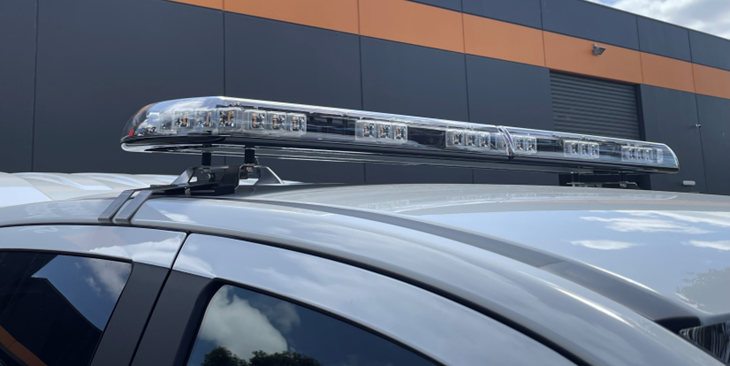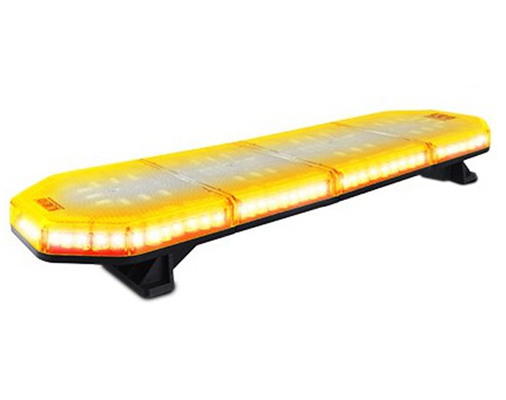Why your light bar isn’t working & how to fix it
For emergency fleets, reliable lighting isn’t just a convenience—it’s critical. Whether responding to an incident in Australia’s rugged rural areas or navigating through remote, poorly lit roads during the night, LED light bars are essential for ensuring visibility and safety.
But as with any electrical component, these light bars can stop working if they are damaged, faulty or installed incorrectly. And when they fail to function, the situation demands immediate attention.
Wondering ‘why is my LED light bar working?’
We’re here to help. In this blog, the team at Australian Warning Systems shares expert troubleshooting advice tailored to emergency fleets. From addressing faulty wiring to resolving connection issues, we’ll guide you through practical solutions to get your LED light bar back in action.
The most common reason an LED light bar isn’t working

A faulty power source is often the main culprit when an LED light bar stops functioning. Before diving into more complex troubleshooting, make sure your lights are properly connected and the power source is operating as it should.
You can easily test the power supply by plugging a different device into the same outlet to see if it powers on. If the outlet seems fine, then consider testing or replacing your LED power supply.
We strongly advise against disassembling your light at any point during troubleshooting. Attempting to do so may void the product warranty.
A flickering or flashing light bar
If your LED light bar is flickering in a regular pattern, such as flashing every second, it’s a clear sign that something isn’t quite right. Flickering or inconsistent lighting can be more than frustrating – it may compromise visibility in crucial moments.
When your light bar isn’t working as it should, there are a few steps you can take to diagnose the issue.
Here’s a breakdown of the most likely causes and solutions:
Power supply problems
If your LED light isn’t functioning properly despite having power, the issue could lie with the power supply. An overloaded power supply often cycles on and off repeatedly, creating a flickering or flashing effect.
To resolve this, upgrade to a power supply with sufficient capacity to meet the wattage requirements of your LEDs. Make sure to follow the manufacturer’s recommendations when choosing a power supply.
Since LEDs run on low-voltage DC, they need a power source that can effectively convert 120V/240V AC into the appropriate voltage. Remember, voltage requirements can vary based on your location, so double-check compatibility before making a purchase.
Device interference
If your light bar flickers and your vehicle has other electronic devices using radio frequency (RF) signals—such as radios, CBs, or GPS units—interference could be to blame. This is particularly common if the light bar includes a built-in controller or dimmer that also relies on RF signals.
To reduce this interference, try to:
- Isolate the light bar from other devices
- Use shielded cables
- Add ferrite cores to the cables
Defective drivers or LED chips
Flickering or flashing can also occur if the LED chips or drivers within the light bar are damaged or faulty.
This might be due to manufacturing flaws, overheating, moisture exposure, or excessive vibration. In cases like this, reach out to the manufacturer or retailer to request a replacement or refund.
The wrong switch or relay
If a switch or relay isn’t designed for LED technology, it might struggle to manage the low current draw of an LED light bar – resulting in flickering or malfunctioning.
To resolve this, replace the switch or relay with one specifically designed for LED lights. Make sure it is installed correctly, with proper wiring and secure grounding, to eliminate any issues and ensure reliable performance. More on this below.
Unresponsive earth
A faulty ground connection is often the root cause of partially illuminated or flickering lights. To test for a bad earth connection, try switching the chassis ground to the battery’s negative terminal.
Keep in mind that checking voltage at the light connector isn’t a reliable way to diagnose this issue; it’s possible to have 14v+ at the connection but still experience poor grounding, which ultimately results in insufficient power input.
Your light bar is too dim

If your LED light bar isn’t shining as brightly as expected, a few common issues could be to blame. By addressing these issues, you can restore your light bar’s performance and enjoy the illumination and reliability LEDs are known for.
Incompatible power supply
One of the most frequent causes is an incompatible power supply. LEDs require a driver that matches their specific power, voltage, and current requirements to perform at their best.
If the voltage or current is too low – for example because the battery or the alternator of the vehicle is faulty or failing – the light bar won’t be getting sufficient or stable power. As a consequence, LEDs may appear dim or show an inconsistent lighting pattern.
To resolve this, check the power specifications and ensure your battery is fully charged or replaced if necessary.
Loose wiring
Another potential issue is loose wiring, which can curb the power reaching the lights. To address this issue, inspect the wiring for any damage or signs of wear, and tighten connections or replace the wires as needed.
A multimeter can help you check the voltage and continuity to ensure the wires are working correctly. If you’re unsure, an electrician can help resolve any weak points in the setup.
General wear and tear
If your LED light bar has been in use for a while, a gradual decrease in brightness could simply be due to natural wear and tear. Over time, LED bulbs lose some of their lumen output as part of their normal ageing process.
That said, this is less likely to be the root cause, given the long lifespan of high-quality LEDs. Investing in premium LED bulbs helps ensure optimal brightness and longevity, reducing the risk of early burnouts.
The light bar burns out too quickly
If your LED light bar is failing faster than it should, it’s more than just inconvenient—it’s a safety hazard. Unreliable lighting in these moments can impact your ability to deliver emergency responses effectively.
Picture this: you’re driving through a remote, poorly lit stretch of road or responding to an emergency, and your light bar flickers and burns out, leaving you with reduced visibility when you need it most.
Here’s the most likely reason your light bar is burning out fast:
Incorrect fittings
If your light bar seems to stop working sooner than expected, the issue might be related to the LEDs’ placement in older fittings designed for traditional bulbs.
Unlike older bulbs, LEDs generate significantly less heat and can struggle when exposed to high temperatures. Enclosed fittings or proximity to high-wattage bulbs that emit excessive heat can cause LEDs to overheat and fail earlier than expected.
To prevent this, make sure to replace all the bulbs in a fitting at the same time rather than waiting for individual ones to burn out. This reduces the risk of overheating and ensures a consistent, reliable light output.
A humming or buzzing light bar
A slight humming or buzzing sound from your LED light bar might not seem like a big deal—and in most cases, it isn’t.
But if you hear crackling or buzzing from the switch, outlet, or wiring, it’s time to act fast. This could signal a more serious electrical issue, and reaching out to a qualified electrician is the safest move.
As for the buzzing from your light bar itself, it’s often caused by an inconsistent electrical current. This can happen for several reasons, like an incompatible power source or faulty wiring. Let’s look at each one.
Circuit disruptions
A weak or mismatched power supply is often the cause of LED strip problems. If your power supply isn’t providing the correct voltage or current, upgrading to a higher-quality unit designed for your LED strip can help.
Another possible issue is sharing the circuit with high-powered appliances, like fans or heaters. These devices draw significantly more power than LEDs, and when they switch on, the sudden surge in the circuit can disrupt the LEDs.
While LEDs are designed with internal drivers to handle voltage fluctuations, excessive surges can still cause problems. If you suspect this is the issue, it’s a good idea to have an electrician inspect the circuit and make necessary adjustments.
Want an extra layer of protection?
A power supply with a built-in voltage regulator can work wonders. It keeps the current steady, your LEDs safe, and those annoying flickers at bay. Sometimes, a little upgrade is all it takes to get your lights back in perfect sync!
An incompatible dimmer switch
If your light bar flickers or buzzes, the issue may lie with an outdated or incompatible dimmer switch. Many older dimmer switches, built for incandescent or halogen bulbs, don’t work well with modern LEDs.
Unlike traditional bulbs that vibrate physically to create noise, LEDs are electronic devices, and any humming or buzzing is typically caused by the internal components of the LED driver.
Start by reviewing the specifications for your LED system to confirm whether the dimmer switch is suitable. If not, replacing it with one designed for LEDs can often resolve the issue.
Another option is to add a bypass capacitor to the output terminals of the dimmer switch. This reduces electrical noise and helps provide a more stable current, minimising unwanted sounds. This approach is best handled by a qualified electrician or someone with electrical expertise.
To identify the source of the problem, you can temporarily bypass the dimmer switch by connecting the LED driver directly to the power source.
If the flickering or buzzing stops, it’s a strong indicator that the dimmer switch and driver aren’t compatible. Upgrading to a compatible model should resolve the problem.
Low quality LED Driver
If you think your LED driver might be the source of the noise, upgrading to a better-quality driver could solve the problem.
Choose one with advanced features like electromagnetic compatibility (EMC) filters or active power factor correction (PFC). These help reduce electrical interference and eliminate unwanted noise.
Poor installation
A shaky installation can be the root cause of many LED strip issues. Ensure your LED strip is securely mounted, with no loose or dangling sections, and double-check that all connections are snug and properly aligned.
Proper grounding is also essential to reduce the risk of electrical interference or unwanted noise.
If you’re working with magnetic drivers, rubber gaskets can be a game-changer. Acting like shock absorbers, these gaskets sit between the components of the driver, soaking up vibrations before they can transform into that irritating hum or buzz. By keeping vibrations in check, you’ll create a quieter, more reliable setup.
Too much heat and moisture
Keep an eye on your LED strip’s temperature to ensure it stays within the recommended range. If overheating is an issue, consider adding heat sinks or improving ventilation to help regulate the temperature.
Additionally, shield your LED strip from moisture or humidity by applying proper sealing or using weatherproofing solutions. These steps will help extend the life of your LED strip and maintain its performance.
Explore a full range of LED light bars for your fleet

Now that you know why your light bar isn’t working, it’s time to fix the issue and upgrade your lighting setup.
The easiest way to avoid frustrating issues with LED lights is by choosing high-quality light bars installed by professionals—and that’s exactly what we offer at Australian Warning Systems.
Our robust LED lighting solutions are built for reliability and performance, catering to the various needs of emergency vehicles.
When you invest in light bars from us, you’re choosing a cost-effective, energy-efficient option that enhances visibility, supports safety, and meets industry standards.
Discover the ultimate lighting solution for your fleet today. For expert advice on selections, call 03 9796 5880 or email info@warningsystems.com.au.


